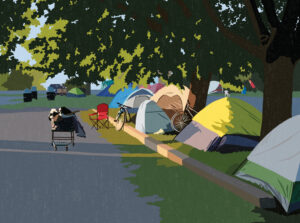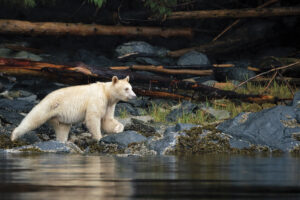
People & Culture
Kahkiihtwaam ee-pee-kiiweehtataahk: Bringing it back home again
The story of how a critically endangered Indigenous language can be saved
- 6310 words
- 26 minutes
This article is over 5 years old and may contain outdated information.
People & Culture

Six days into our attempt to summit Mt. Saskatchewan, the only unconquered peak in the Yukon’s Centennial Range, my three fellow climbers and I were stuck at the base of a col, 9,700 feet (about 2,950 metres) high.
We’d decided to take a break here until nightfall, when the snow would harden and make it possible for us to go safely down the slope to our high camp. That was until the blizzard hit.
Huddled in a hole with an emergency tarp overhead, we had to make a decision. Outside the shelter’s opening where we’d jammed our packs to keep out the wind, it was a complete whiteout.
We couldn’t go down the slope yet, because we knew it was going to slide. We couldn’t just wait out the storm, because the increased snowfall was further increasing the chance of us being buried by an avalanche. The temperature was starting to drop. I’m pretty sure I got a little frostbite on my toes from that day.

I’ve been climbing with Jeff Dmytrowich, Wren Rabut and Sam Unger for quite some time. We practiced and trained together for six months prior to the climb. We’ve done alpine climbs, ice and rock climbs, you name it. Jeff has climbed in the Himalayas, and he and I have both been Alpine Club of Canada Saskatchewan section trip leaders in the past together. Wren and I have done a number of alpine climbs together. We work really well as a team. We all had the Alpine Club’s mandate to uphold: safety first, summit second. That blizzard was a game changer. It was starting to look as though we’d have to sacrifice Mt. Saskatchewan’s summit for our safety.
We kept our spirits up. We had one heavy belay down jacket—the thick one we’d wear when we were belaying while our partners climbed—that we were splitting among the four of us trying to stay warm.
The decision came down to this: how long could we stay hunkered down beneath the tarp? We would soon run out of food and water, so we started rationing. The longer we waited, the higher the risk of an avalanche. The heavy snowfall was also covering our tracks from our basecamp. We’d marked our trail to our anchor higher up at 10,500 feet (3,200 metres) with wands, but we didn’t have enough wands to mark our first trail from high camp. That meant we might have to risk barreling down a slope only to hit a moat—the snow-filled gap between a glacier and the base of the mountain—which can be more dangerous than falling into a crevasse.
Sam had also taken a bit of a fall earlier in the day, where we thought he was on a rock ledge and his leg broke through, leaving him dangling over a 2,000-foot (610-metre) drop, and we’d had to pull him back to our anchor.
Every time I have to make a tough decision, I’m reminded of my responsibilities as expedition leader. There’s the legal responsibility you carry for your team when you’re climbing a mountain. In this case, I was also financially responsible for the expedition. As the most experienced climber on the team, I also knew our loved ones were depending on me to get the team home safe. It’s often happened to me that a family member, usually the father, of a fellow expedition member has grabbed my arm, looked me in the eyes, and said, “Bring my boy home safe.”
So here we were left with a decision to make. Despite all the dangers, we still hadn’t quite given up on our goal to reach the summit. But with any climbing expedition, we all had to remember that the difficult part isn’t necessarily getting to the top. It’s getting back down again.
This post is part of a series. To read other posts by this author, click here. Click here to learn more about The Royal Canadian Geographical Society-supported Mount Saskatchewan Climb.
Are you passionate about Canadian geography?
You can support Canadian Geographic in 3 ways:

People & Culture
The story of how a critically endangered Indigenous language can be saved

Places
In Banff National Park, Alberta, as in protected areas across the country, managers find it difficult to balance the desire of people to experience wilderness with an imperative to conserve it

People & Culture
For unhoused residents and those who help them, the pandemic was another wave in a rising tide of challenges

Wildlife
How ‘maas ol, the spirit bear, connects us to the last glacial maximum of the Pacific Northwest